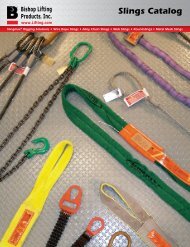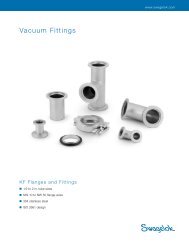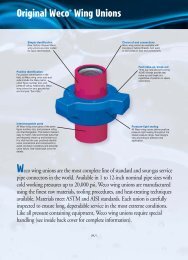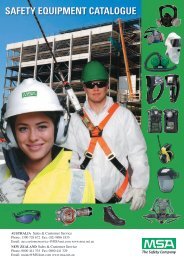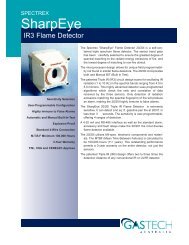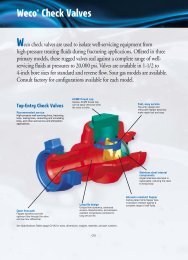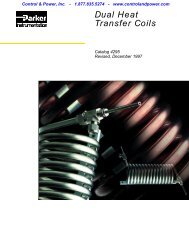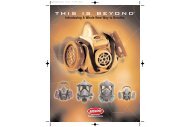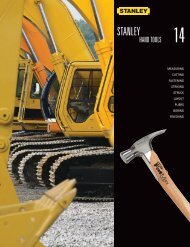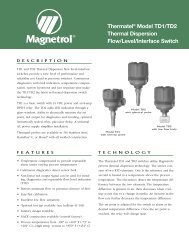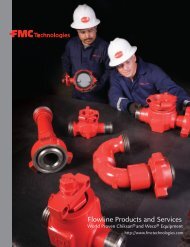You also want an ePaper? Increase the reach of your titles
YUMPU automatically turns print PDFs into web optimized ePapers that Google loves.
Inspections and Test Proceduresof Twin-Path ®ProductsInspections of Twin-Path ® ProductsTell-Tails should extend past the tag area of each sling. If both Tell-Tails are not visible, remove the sling from service. If any partof the sling shows evidence of chemical degradation, remove it from service. Send to manufacturer for repair evaluation.<strong>Slings</strong> should be inspected for evidence of cutting or tearing of the outer cover. <strong>Slings</strong> with cuts should be removed from serviceand sent back to the manufacturer for repair evaluation. Damage to the cover may indicate core damage.Inspect slings for evidence of heat damage. Aramid Sparkeater <strong>Slings</strong> should not be exposed to temperatures over 149°C/300°F.K-Spec ® and Polyester Core <strong>Slings</strong> should not be exposed to temperatures above 82°C/180°F. Cold temperature exposure down tominus 40°C/minus 40°F do not effect the strength of the products. Other temperatures should be referred to the manufacturer.<strong>Slings</strong> using aluminum fittings shall not be used where fumes, vapors, sprays, or mists of alkalis or acids are present.Twin-Path ® Lifting <strong>Slings</strong> and any fittings attached should be the subject of frequent and regular inspections. In addition to theinitial inspection by a <strong>com</strong>petent person and frequent written inspections, the slings should be visually inspected before each use.Written inspections should be performed as required and documents of such inspection by a <strong>com</strong>petent person shall be kept onfile in the safety department of the plant or site where used. Inspections may be done more often based on frequency of use, severityof conditions, experience of past service life.<strong>Slings</strong> should be examined throughout their length for abrasion, cuts, heat damage, fitting distortion or damage, tag legibility,and if any doubts are held by the inspector, the sling should be removed from service. Core integrity is determined by fiber optic lighttransfer if this type of tell-tail is installed in the sling. If a deterioration is found, the sling must be removed from service and returnedto the manufacturer for evaluation.<strong>Slings</strong> removed from service that are not capable of repair should be destroyed and rendered <strong>com</strong>pletely unfit for futureuse.Abrasion, heat damage or cuts to the cover may indicate a loss of strength to the load core and these slings should not be used untilevaluated by the manufacturer. At area of damage, cover should be opened and the core yarns counted and visually inspected.SLINGMAX ®Test Procedures for Complete Twin-Path ® Sling ProductsFor proof testing, the pins shall be 1˝ diameter or larger.Proof tests shall consist of pulling the slings to twice their rated capacity. <strong>Slings</strong> shall be held at the proof test limit for a minimumof 15 seconds and then the tension may be released.Testing of Twin-Path ® Sling products and load yarn shall be on a testing machine, which meets or exceeds the standards asdescribed in ASME E-4.Break testing of slings shall be as above with results documented. Pin size for break testing should be a diameter equal to half thenominal sling width or larger.Proof testing is mandatory for every newly manufactured and repaired Twin-Path ® sling.After the sling is proof tested, the Tell-Tails should then be trimmed to length prior to shipment.Repaired fittings or slings shall be proof-tested before they are returned to service.THESE RECOMMENDED STANDARD SPECIFICATIONS HAVE BEEN FORMULATED AS A GUIDE TO USERS, INDUSTRYAND GOVERNMENT TO INSURE THE PROPER USE, MAINTENANCE AND INSPECTION OF TWIN-PATH ® LIFTING SLINGPRODUCTS.(800) 972-1041 Slingmax ® 25



